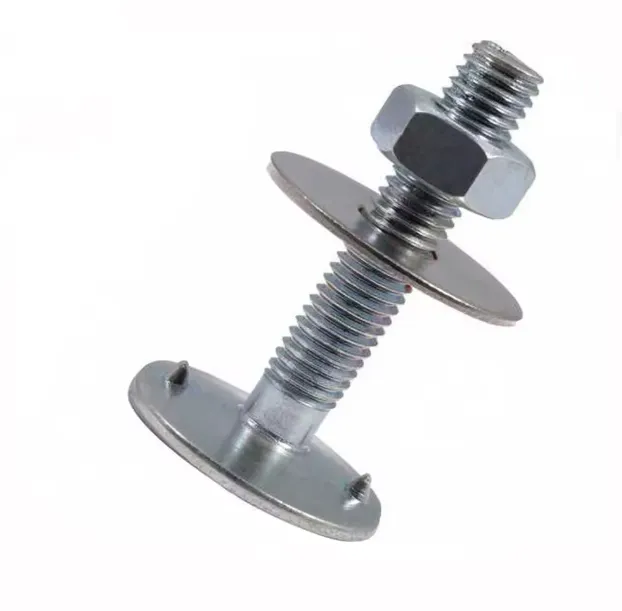

top lock flange nut
Nov . 11, 2024 20:13 Back to list
top lock flange nut
Understanding Top Lock Flange Nuts A Key Component in Fastening Technology
In the world of industrial fastening, the top lock flange nut emerges as a crucial element designed for stability and reliability in various applications. The unique design of this type of nut allows for efficient fastening while providing resistance to loosening, making it an essential choice for engineers and manufacturers across multiple sectors. This article explores the characteristics, benefits, and applications of top lock flange nuts.
What is a Top Lock Flange Nut?
A top lock flange nut is a specialized type of nut featuring a built-in flange or washer-like base. This flange increases the surface area that comes into contact with the substrate, thereby distributing the load over a larger area. The top lock aspect refers to a mechanical design that enhances the nut's ability to resist loosening due to vibration and torque. This is primarily achieved through a series of serrations or undulations on the surface of the flange, which bite into the material it is mounted on, providing a secure grip.
Advantages of Top Lock Flange Nuts
One of the main advantages of using top lock flange nuts is their self-locking feature. The serrated design prevents the nut from loosening, even in high-vibration environments, which is a common issue in applications such as automotive assembly, railways, and heavy machinery. This feature not only decreases the risk of failures due to loosening but also minimizes maintenance needs and costs associated with re-tightening fasteners.
Additionally, the flange provides added benefits by acting as a washer. This reduces the number of components needed in fastening assemblies, simplifying the design and potentially reducing assembly time. The wide base helps to prevent damage to the surface beneath the nut, which is particularly valuable in applications where aesthetics and surface integrity are important.
Material Options
top lock flange nut

Top lock flange nuts are available in a variety of materials, including carbon steel, stainless steel, and various composite materials. The choice of material often depends on the specific requirements of the application, including strength, weight, corrosion resistance, and cost considerations. Stainless steel, for instance, is frequently used in marine applications due to its resistance to rust and corrosion, ensuring longevity and reliability even in harsh environments.
Applications
The versatility of top lock flange nuts makes them suitable for a myriad of applications. They are commonly found in automotive manufacturing, where vibrations are an ordinary occurrence. They are also utilized in construction, machinery, and heavy equipment, where securing various components is critical for overall safety and functionality. The aircraft industry also employs top lock flange nuts due to their ability to resist loosening under extreme conditions, such as high altitudes and fluctuating temperatures.
Installation and Maintenance
Installing top lock flange nuts typically requires standard torque specifications, similar to traditional nuts. However, it’s essential to ensure that the mating surface is clean and free of debris to achieve maximum locking effectiveness. Maintenance of assemblies using top lock flange nuts is generally minimal due to their self-locking properties. Yet, periodic inspections are advisable, especially in high-vibration applications, to ascertain overall system integrity.
Conclusion
In conclusion, top lock flange nuts represent a significant advancement in fastening technology, offering innovative solutions to common problems associated with traditional nuts. Their ability to resist loosening, combined with the functional benefits of the flange design, makes them a preferred choice in various high-performance applications. Understanding these nuts' features and applications can significantly contribute to engineering project success, ensuring that components remain securely fastened even under the most demanding conditions. As industries continue to evolve, the importance of reliable fastening will only amplify, leading to broader adoption of specialized components like the top lock flange nut.
Latest news
-
High-Strength Hot-Dip Galvanized Bolts-Hebei Longze|Corrosion Resistance&High Strength
NewsJul.30,2025
-
Hot Dip Galvanized Bolts-Hebei Longze|Corrosion Resistance&High Strength
NewsJul.30,2025
-
Hot Dip Galvanized Bolts - Hebei Longze | Corrosion Resistance, High Strength
NewsJul.30,2025
-
High-Strength Hot Dip Galvanized Bolts-Hebei Longze|Corrosion Resistance, Grade 8.8
NewsJul.30,2025
-
Hot Dip Galvanized Bolts-Hebei Longze|Corrosion Resistance,High Strength
NewsJul.29,2025
-
High-Strength Hot Dip Galvanized Bolts - Hebei Longze Metal Products Manufacturing Co., Ltd.|corrosion resistance&high strength
NewsJul.29,2025

